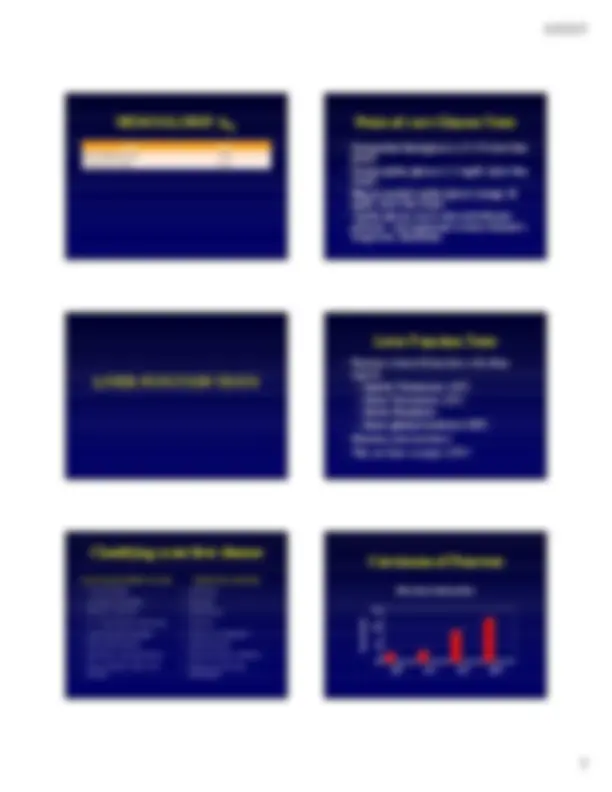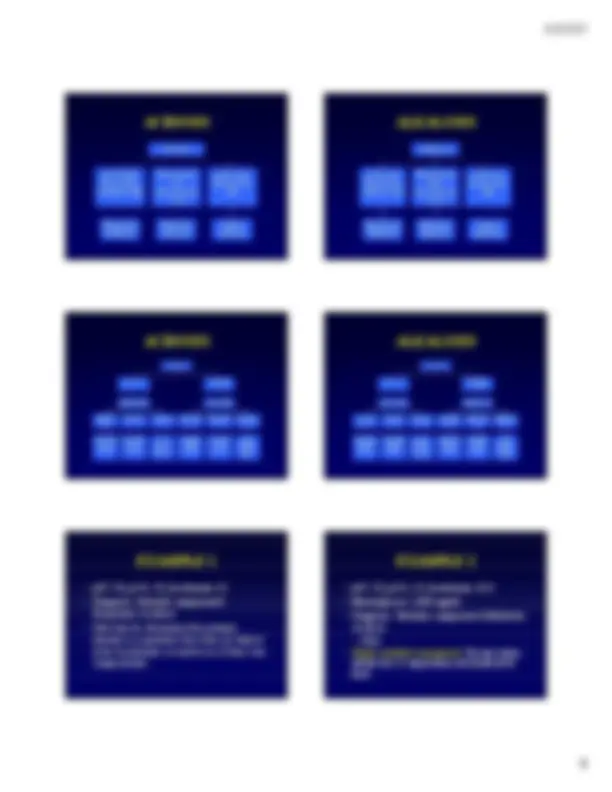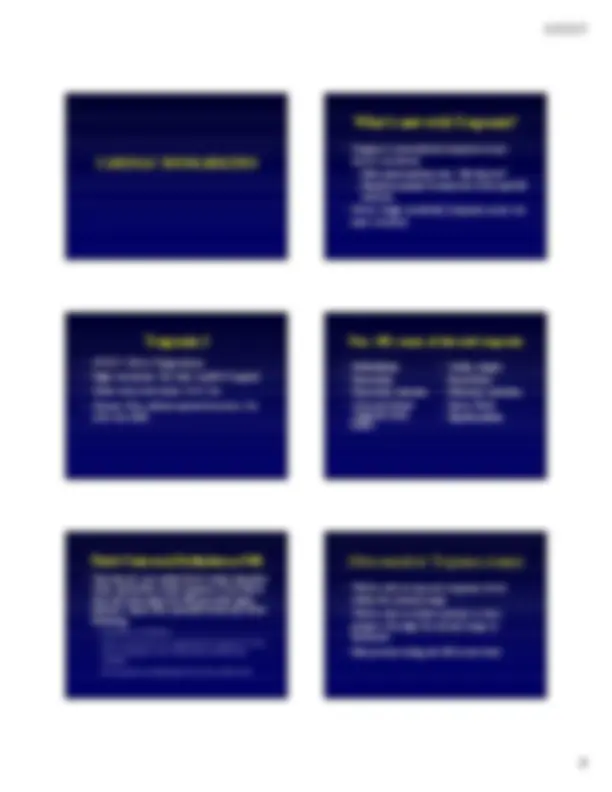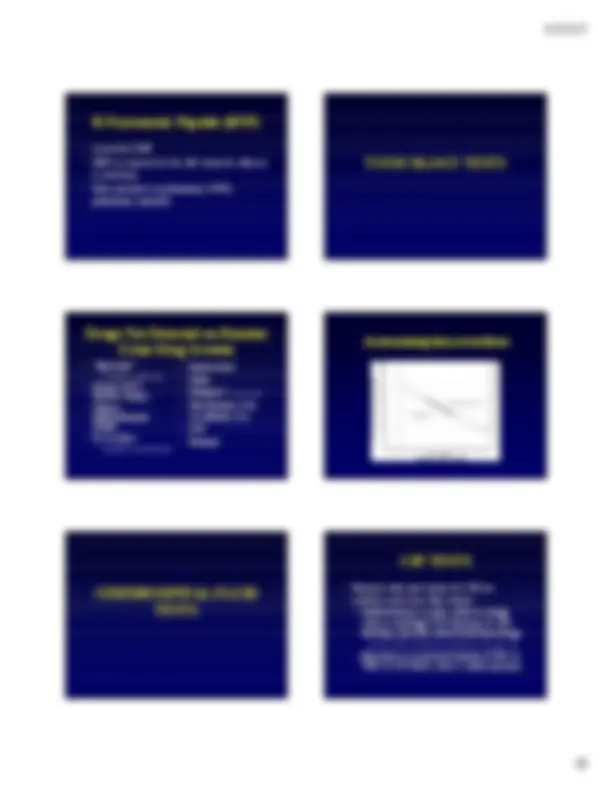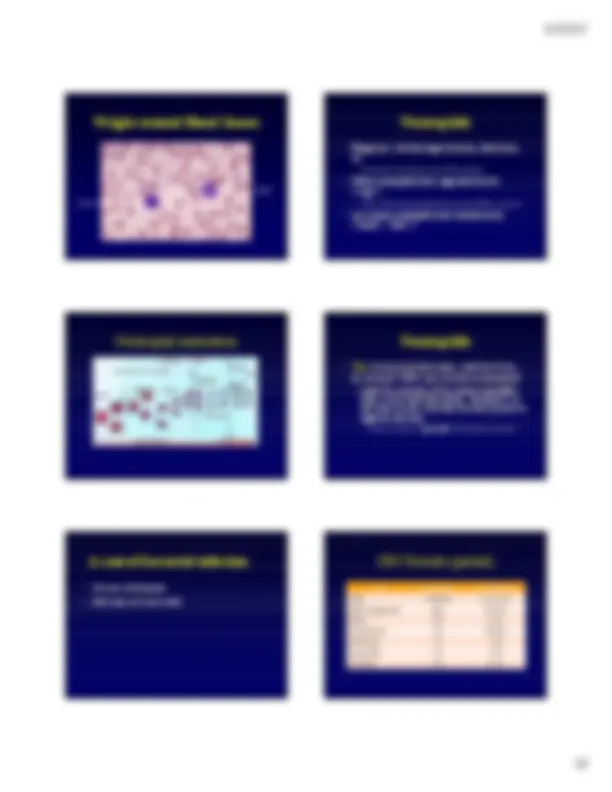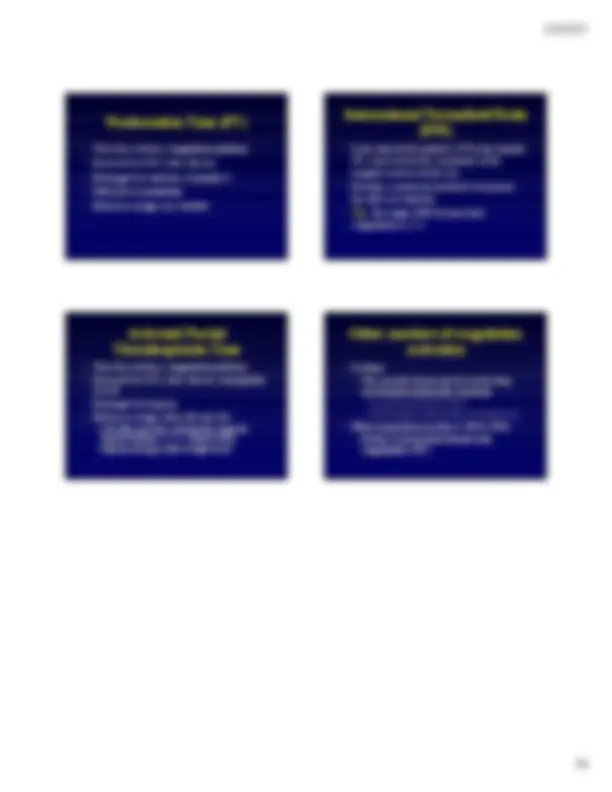Download Case Study: Lab Tests & Interpretations on Electrolytes, Renal & Liver Function and more Study notes Nursing in PDF only on Docsity!
Some things you should
know about laboratory
tests …But maybe you
don’t
Steve Faynor, CCEMT-P HCA Chippenham Medical Center Richmond Ambulance Authority
When lab tests are useful
- Managing patients during critical care transports
- While transporting patient to medical facilities for evaluation of laboratory abnormalities
Objectives
- Review some basic laboratory tests.
- Appreciate how patterns of laboratory test results can offer insight into etiology.
- Learn how laboratory test calculations can add additional clinical information.
- Review some limitations of laboratory tests.
Treat the patient, not the
laboratory values.
ELECTROLYTES &
RENAL FUNCTION TESTS
A case of “bad labs”
Hypernatremia & Renal Failure
- 89 year old white female
- Coming from nursing home due to abnormal labs
- Sodium 172 mmol/L
- Potassium 4.2 mmol/L
- Chloride 137 mmol/L
- Carbon dioxide 21 mmol/L
- What are some causes of hypernatremia?
Hypernatremia
- Hyperaldosteronism
- Cushing’s disease or syndrome
- Diabetes insipidus (deficiency of ADH)
- Dehydration
- BP 122/66, SBP 99 later
- HR 64/min
- RR 21/min
- SpCO 2 98% on 4 L oxygen per min
- Tongue dry, skin turgor poor
- What is the cause of the hypernatremia in this patient? Treatment?
- BUN 212 mg N/dL
- Creatinine 6.10 mg/dL
- What do these values indicate?
- Does this change your therapy?
Acute Renal Failure
- Intrinsic renal disease
- Acute tubular necrosis: ischemia, toxins
- Acute glomerulonephritis
- CKD with missed dialysis
- Post-renal
- Obstruction: stone, tumor, enlarged prostate
- Pre-renal
- Dehydration, shock, heart failure
Use of the BUN/creatinine ratio
- In intrinsic causes of acute renal failure, the BUN/creatinine ratio is typically 10-15.
- In pre-renal causes of acute renal failure, the BUN/creatinine ratio is typically >20.
- In this case, the BUN/creatinine ratio was 34.8.
- Do you want to stick with the same treatment?
Anion Gap
High Anion Gap Metabolic Acidosis Normal Anion Gap Metabolic Acidosis Lactic acidosis (metformin) Ketoacidosis (diabetic, alcoholic, starvation) End-stage renal failure Methanol intoxication Ethylene glycol intoxication Salicylate intoxication Diarrhea (most common)
MUDPILES
Toxin Organic acid that accumulates (Unmeasured anion) Methanol Formic acid Uremia Uremic toxins Diabetic ketoacidosis Acetoacetate, β-hydroxybutyrate Paraldehyde Iron or isoniazid Lactic acid from iron toxicity Ethylene glycol Oxalic acid (binds calcium) Lactic acidosis Lactic acid Salicylates (aspirin) Salicylic acid
CASE STUDY 2
- Na 129, Cl 78, tCO 2 12
- Anion Gap = 129 – (78 + 12) = 39
- Blood glucose = 1,890 mg/dL
- Diagnosis is diabetic ketoacidosis
HYPERKALEMIA
- Is the sample hemolyzed?
- Hemolysis raises potassium
- How old is the sample?
CALCIUM
Chemical form Percentage Free (ionized) 47% Protein-bound (mostly albumin) 43% Complexed (phosphate, carbonate, citrate, etc.) 10% pH incr.-> Ca2+^ + albumin-H Ca-albumin complex + H+ <-pH decr.
- If the albumin is significantly decreased (malnutrition, liver disease), the total calcium will be low but the ionized calcium may be normal.
HEMOGLOBIN A1c
Glycosylated Hemoglobin
- Glucose reacts non-enzymatically with hemoglobin to form HbA1c
- The extent of glycosylation increases with increasing glucose concentration
- The HbA1c level is an indication of the average glucose level for the past 3 months
- Reference Range: 4-6%
HEMOGLOBIN A1c
Usage Cutoff Goal for diabetic control <7.0% Screening for diabetes >6.5%
Point-of-care Glucose Tests
- Fasting whole blood glucose is 12-15% lower than plasma.
- Fasting capillary glucose is 2-5 mg/dL higher than venous.
- But post-prandial capillary glucose averages 30 mg/dL higher than venous.
- Capillary glucose may be depressed with poor perfusion: cold, hypotension or shock, Raynaud’s, vasopressors, dehydration.
LIVER FUNCTION TESTS
Liver Function Tests
- Enzymes released from liver cells when injured - Aspartate Transaminase (AST) - Alanine Transaminase (ALT) - Alkaline Phosphatase - Gamma-glutamyl transferase (GGT)
- Bilirubin, total and direct
- Why are there so many LFTs?
Classifying acute liver disease
Acute hepatocellular necrosis
- Viral hepatitis
- Alcoholic hepatitis
- Wilson’s disease
- α-1 Anti-trypsin deficiency
- Autoimmune hepatitis
- Hemochromatosis
- Infectious mononucleosis
- Non-alcoholic fatty liver disease Obstructive jaundice
- Gallstone
- Stricture
- Granuloma
- Abscess
- Tumor or metastasis
- Drug-induced
- Primary biliary cirrhosis
- Primary sclerosing cholangitis
Carcinoma of Pancreas
0 5 10 15 Times ULN AST ALT ALP GGT Bile duct obstruction
Laboratory Studies
• CBC
- Hemoglobin = 2.4 g/dL
- MCV normal (normocytic)
- MCHC normal (normochromic)
- Reticulocyte count increased
- Direct anti-globulin (Coombs test) positive
- Sign that RBCs are coated with antibodies
Laboratory Studies
- Chemistry tests
- Bilirubin
- Total bilirubin increased
- Indirect bilirubin increased, more than direct
- Ammonia normal
- Enzyme tests
- AST & LDH increased
- Alkaline phosphatase & GGT WNL
Laboratory Studies
- Urine tests
- Urine bilirubin (bile) negative or weak pos.
- Urine urobilinogen increased
Bilirubin Metabolism
Acid-Base and Blood Gases
Diagnosing Acid-Base
Disorders
- Look at the pH first
- If pH<7.35 Acidosis
- If pH>7.45 Alkalosis
- Look at the CO 2 and bicarbonate next to determine the primary cause.
- Once you have determined the primary cause, determine if there is compensation by the other component.
ACIDOSIS ALKALOSIS
ACIDOSIS ALKALOSIS
EXAMPLE 1
- pH 7.28, pCO 2 58, bicarbonate 33
- Diagnosis: Partially compensated Respiratory Acidosis
- Note that we determined the primary disorder is respiratory first, then we looked at the bicarbonate second to see if there was compensation.
EXAMPLE 2
- pH 7.28, pCO 2 23, bicarbonate 10.
- Blood glucose 1,890 mg/dL
- Diagnosis: Partially compensated Metabolic Acidosis - DKA
- Tip for ventilator management: The low carbon dioxide here is compensatory and should not be fixed.
B-Natreuretic Peptide (BNP)
- A test for CHF
- BNP is released by the left ventricle when it is stretched
- False-positives in pulmonary HTN, pulmonary embolus
TOXICOLOGY TESTS
Drugs Not Detected on Routine
Urine Drug Screens
- “Bath Salts”
- Ecstasy (XTC, MDMA, Molly)
- Gamma- hydroxybutyrate (GHB)
- K-2 or Spice
- Synthetic cannabinoids
- Jimson weed
- Salvia
- Rohypnol (flunitrazepam)
- Metcathinone (Cat)
- 25I-NBMD (25I)
- LSD
- Fentanyl
Acetaminophen overdose
CEREBROSPINAL FLUID
TESTS
CSF TESTS
- Normal color and clarity of CSF are colorless and clear (like water) - Xanthochromia is a pink, yellow or orange color in centrifuged CSF indicative of CNS bleeding, especially subarachnoid hemorrhage. - Most useful if patient presentation is delayed >6h. - Pleocytosis is an increased number of RBC or WBC in CSF which causes a cloudy specimen
CSF TESTS
- Tip: In bacterial meningitis, look for a cloudy specimen with elevated WBC, protein and lactate, decreased glucose, and presence of bacteria on the Gram stain.
Bacterial Meningitis
- Normal CSF glucose is ≈ 2/3 of serum
- CSF glucose <1/2 of serum is suggestive of bacterial meningitis
- CSF WBC >1,000/μL usually caused by bacterial meningitis
URINALYSIS
Urinalysis Patterns
- Urinary tract infections
- Dysuria, cloudy, odor, RBC (chem & micro), WBC (chem & micro), protein, bacteria (chem [nitrite] & micro)
- “Nephritic” urine
- Acute glomerulonephritis
- RBC, WBC, protein, RBC & WBC casts
- Hyperglycemia
- Tip: Berra’s Rule: “You can see a lot by looking.”
Urinary tract infection
Wright-stained Blood Smear
PMN Lymph
Neutrophils
- Phagocytic cells that ingest bacteria, dead tissue, etc. - Increased in infections and inflammation
- Mature neutrophils have segmented nuclei (“segs”) - Also called polymorphonuclear cells (PMNs, “polys”)
- Less mature neutrophils have banded nuclei (“bands”, “stabs”)
Neutrophil maturation Neutrophils
- Tip: In bacterial infections, look for fever, an elevated WBC and elevated neutrophils. - Look for a increase of less mature neutrophil forms in the blood (the bands, “bandemia”) as the body recruits cells from the bone marrow to fight the infection. - This is called a “left-shift” for historical reasons.
A case of bacterial infection
- 36 year old female
- Infection of chest wall
CBC Results (partial)
Cell Percentage Normal Range WBC 11,800/μL 4.5-11 103 PMN (segmented) 64% 50-70% Bands 21% 0-5% Lymphocytes 5% 20-40% Monocytes 7% 1-6% Eosinophils 3% 1-5% Basophils 0% 0-1%
Prothrombin Time (PT)
- Tests the extrinsic coagulation pathway
- Increased by DIC, liver disease
- Prolonged by warfarin (Comadin®)
- Difficult to standardize
- Reference ranges are variable
International Normalized Ratio
(INR)
- Is the ratio of the patient’s PT to the normal PT, corrected for the sensitivity of the reagents used to do the test
- Provides a universal yardstick to measure the effect of warfarin
- Tip: The target INR for most anti- coagulation is 2-3.
Activated Partial
Thromboplastin Time
- Tests the intrinsic coagulation pathway
- Increased by DIC, liver disease, hemophilia A & B
- Prolonged by heparin
- Reference ranges often lab-specific
- Lab often specifies a therapeutic range for heparin therapy (1.5-2 normal value)
- Heparin dosing is often weight-based
Other markers of coagulation
activation
- D-dimer
- Very sensitive but not specific test for deep vein thrombosis/pulmonary embolism - Use to rule out, not rule in DVT - Will be positive wherever there is bleeding & clot
- Fibrin degradation products (FDP, FSP)
- Positive in disseminated intravascular coagulopathy (DIC)



